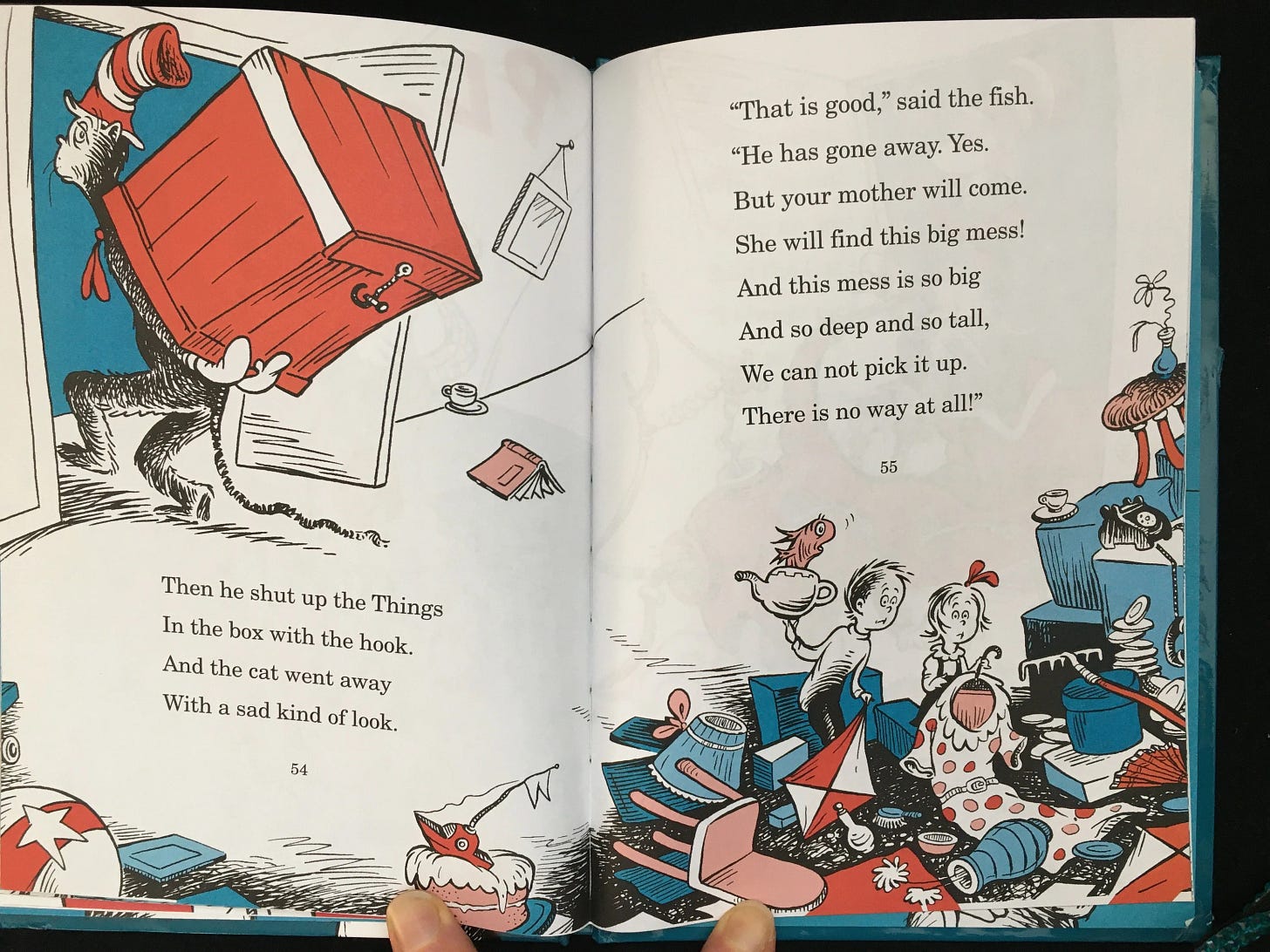Beautifully Broken Issue #47: What's "The Real Problem" & The Lesson Of The Cat In The Hat
IDEAS, ART & WISDOM TO REPAIR OUR BEAUTIFUL WORLD
IDEAS: What’s “The Real Problem” & The Lesson Of the Cat In The Hat
What is "the problem"?
A lot of media discourse and interpersonal conversation ranges over the topics of what’s really going wrong with the world.
Leftist politics?
The far right?
Communism?
Capitalism?
Billionaires, artificial intelligence, drugs, feminism, the manosphere, taxation, DEI policies, exclusionary policies, immigration, the welfare state, extremism, healthcare, education, religion?
The list never ends and there’s no shortage of people claiming one or all of the issues on this list (and many more) as “the problem” that’s at the root of all your problems. Manosphere influencer Andrew Tate tells teenage boys that feminism is the problem, Fox News tells viewers that the radical left are wrecking the country, billionaires and wannabe billionaires all decry the welfare state and worker rights for getting in the way of profiteering.
I live in France and the discourse on the rotating nature of “the problem” is without end. When I tune into American news, the same question is also endlessly discussed.
“Isms” are one way we keep common sense at bay in order to march on without change: communism, socialism, anarchism, humanism, etc.
Here is George Lucas in an interview suggesting that humans should be able to live a dignified life and express themselves meaningfully. The interviewer wants to know what “ism” that belongs to —”socialism?” “communism?”. Lucas intelligently replies— “common sense”.
We’re pattern-seeking mammals and so we’re happy to be distracted by trails of thoughts and ideas that seem to identify a problem that, if clearly articulated will surely be the one thing that is at the heart of everything that’s going wrong with civilization, society, the nation, our family life, our relationships, etc. Because life is complex and confusing we like simple answers.
Happily there is a single answer at the heart of all our problems, it's the simplest thing in the world, and the last place we ever want to look—in the mirror.
You are the problem, I am the problem. Collectively, humanity itself is the problem.
The Buddha says fear and desire are at the heart of all human problems. Desire itself is a kind of fear of “not having”, so all negative thoughts and emotions can be categorized under the label of “survival fear”.
The ego is the splinter, the break, that has us imagine we are little gods, able to exercise divine power on earth.
If we are gods, then we are gods of the Greek mythological variety—petty, vengeful, lusty, driven by primitive emotions. The Greeks saw clearly the forces that drove humanity’s actions. We might have the superpower of human consciousness but we are also animals in a survival environment (like every animal in physical existence). As such, we are easily manipulated into embracing fear by the idea that one of our essential survival needs is being stolen away from us by an external force: shelter, food, territory, mating rights and tribal belonging are the greatest hits, played again and again not only by politicians but by ourselves to ourselves.
The moment we embrace fear we turn our backs on any connection we have with the divine and make a commitment to darkness and suffering, for ourselves and the world.
The problem of fear and the infinite plague of problems that arise out of it are easily solved by looking in the mirror and turning back to the creation we so desperately want to escape from.
Why don't we do this often and always? I think it is because looking at ourselves squarely in the mirror is hard. What looks back at us? Our commitment to fear and the perversion and arrogance that inevitably warp us the longer we hold onto fear. We come up against hatred of self, hatred for the mess we have made of ourselves and our world. It's not only confronting, it's counter-intuitive to survival.
It seems like the best material-world survival strategy is to desperately ignore our worst self and shore up our immediate needs.
We are more than survival animals driven by fear, however. If we repress our humanity to alleviate this fear then we poison our souls and literally our self. We turn away from the opportunity for spiritual growth in a material world.
Philip K. Dick once described modern society as a Black Iron Prison—a psychic and social structure so pervasive we no longer notice it. He described it as “the empire that never ended”. It isn’t built with stone, but with systems: legal, technological, economic. It looks like freedom but feels like suffocation. And here's the terrifying part: it has no soul. No compassion. No conscience. It’s what happens when the human impulse to organize loses touch with the human capacity to love.
The Black Iron Prison can wear any face—religious, secular, corporate, even humanitarian. Whenever a system forgets the sacredness of the individual, when rules matter more than hearts, when efficiency trumps empathy, the iron begins to form.
In the children’s story The Cat in the Hat, two children are left alone for the day and The Cat appears like a whirlwind to give them the solution to their boredom. He seems like fun at first but soon destroys the entire house as the children run around trying to stop him and undo the ever-increasing catastrophe. There is no better metaphor for the human ego unleashed within the social construct.
Keep reading with a 7-day free trial
Subscribe to Beautifully Broken to keep reading this post and get 7 days of free access to the full post archives.






